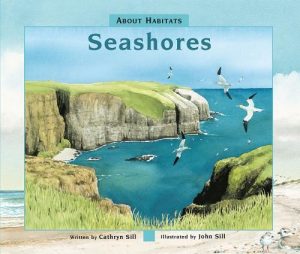Murguia, Bethanie Deeney. The Too-Scary Story. Arthur A. Levine, 2017. 9780545732420. Unpaged. $16.99. PreK-2.
In this charming picture book, two children request that their dad tell them a bedtime story. Grace, the older sister, wants a scary story, while her brother seems less sure of this. Their father begins a tale about two young explorers who are walking through a forest with their dog on their way home. In the darkness, Walter, the young brother, is very worried, but cheers when the darkness is relieved by fireflies. Next they hear a lot of breathing sounds that turn out to be sleeping animals and finally, the “evil shadow” they see is really their father sitting on the bed as he finishes the story. The illustrations are full bleed and done in watercolor, gouache pencil and tissue collage. The “scary” scenes are illustrated with dark colors, while the “non-scary” scenes use a lighter colored palette. The stuffed toys in the children’s bedroom appear in the forest as real animals. Children will enjoy looking for the owl, which appears on each double page spread. THOUGHTS: Murguia’s text is a wonderful and reassuring bedtime story. It also serves as a great read aloud, especially around Halloween, when a non-holiday story is needed. An additional purchase for libraries that want more not “too-scary” stories for young readers.
Picture Book Denise Medwick, West Allegheny School District
Sill, Cathryn. Seashores. Peachtree, 2017. 978-1-56145-968-1. Unpaged. $16.95. K-3.
Sill, Cathryn. Deserts. 978-1-56145-641-3
Sill, Cathryn. Forests. 978-1-56145-734-2
Sill, Cathryn. Grasslands. 978-1-56145-559-1
Sill, Cathryn. Mountains. 978-1-56145-469-3
Sill, Cathryn. Oceans. 978-1-56145-618-5
Sill, Cathryn. Polar Regions. 978-1-56145-968-1
Sill, Cathryn. Wetlands. 978-1-56145-432-7
Seashores is one book in a series of habitat books by Cathryn and John Sill. In this text, the reader learns about seashore ecology around the world. The author discusses the different types of beaches, the landforms surrounding the beach, the effect of tides and various animals that inhabit coastal areas, including some lesser known ones. The text appears in a large font size on the left hand side of the book and is a single simple sentence. On the right side appear the muted watercolor illustrations, which are called plates. John Sill’s meticulous drawings could be displayed as wall art. More information about each plate is included in the back matter, which also contains a glossary and bibliography of books and active websites. It might have been better to include the additional plate information in the body of the text itself, because now the reader must flip back and forth, especially if reading the book aloud. THOUGHTS: Despite this concern about book design, this text is a wonderful introductory resource for young children learning about coastal ecology. Teachers could use this as a read aloud or students could read this alone. Librarians needing books on habitats for primary grades may want to consider this series. (The other books in this series were not available for review).
577.699, Seashore Ecology Denise Medwick, West Allegheny School District


